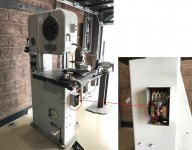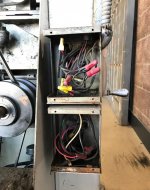Purchased a DoAll model ML bandsaw at auction (photo below). Per the serial number I think it was made in 1950 (first two digits of the SN).

The plate on the machine says it needs 440V 3-phase 60hz power (the standard back in 1950) but we've wired it to 480V 3-phase 60hz (photo below).

The problem is when we turn the saw on it'll run for 5-10 seconds before tripping the B2.10 square D thermal unit inside the on/off switch assembly and shutting off. I've replaced the thermal units but the saw still shuts off after a few seconds (and it smokes from the thermal unit). Photo below of what I'm talking about.

Does anyone have any ideas on what's going on with this thing? This saw is brand new to us and I'm not an electrician so any suggestions would be super appreciated (even if they are obvious ones like check speed settings).
Thank you!

The plate on the machine says it needs 440V 3-phase 60hz power (the standard back in 1950) but we've wired it to 480V 3-phase 60hz (photo below).

The problem is when we turn the saw on it'll run for 5-10 seconds before tripping the B2.10 square D thermal unit inside the on/off switch assembly and shutting off. I've replaced the thermal units but the saw still shuts off after a few seconds (and it smokes from the thermal unit). Photo below of what I'm talking about.

Does anyone have any ideas on what's going on with this thing? This saw is brand new to us and I'm not an electrician so any suggestions would be super appreciated (even if they are obvious ones like check speed settings).
Thank you!







